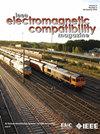金属氧化物压敏电阻在连续早期和中期HEMP传导电流激励下的响应
IF 2
3区 计算机科学
Q3 ENGINEERING, ELECTRICAL & ELECTRONIC
IEEE Transactions on Electromagnetic Compatibility
Pub Date : 2024-12-18
DOI:10.1109/TEMC.2024.3514685
引用次数: 0
摘要
本文章由计算机程序翻译,如有差异,请以英文原文为准。
Response of Metal-Oxide Varistors Excited by Consecutive Early-Time and Intermediate-Time HEMP Conducted Currents
High-altitude electromagnetic pulse (HEMP) can be divided into three parts: 1) early-time HEMP (E1); 2) intermediate-time HEMP (E2); and 3) late-time HEMP (E3). Most studies focus on E1 alone, as E2 and E3 pose lower peak value, especially E2, which is considered less severe than lightning. However, E2 coexists with E1 and affects victim equipment simultaneously, which may result in different effects than E1 or E2 alone. As the most widely used surge protection device, the behavior of metal-oxide varistors (MOVs) under the consecutive E1 and E2 should be investigated and compared with those under E1 or E2 alone. Based on a pulse current injection platform, the voltage, current, susceptibility, and nonuniformity behavior of two types of MOVs under the separate E1, E2, and consecutive E1 and E2 disturbances are investigated and compared. The peak residual voltages of the MOV samples under consecutive E1 and E2 disturbances reach 15 kV, which is the same as that under the E1 disturbance and much higher than that under the E2 disturbance (1.5 kV). The MOV samples are more sensitive to the consecutive E1 and E2 disturbance, particularly those with a higher nonuniformity. Finally, the response process is discussed based on the microstructural nonuniformity of MOVs.
求助全文
通过发布文献求助,成功后即可免费获取论文全文。
去求助
来源期刊
CiteScore
4.80
自引率
19.00%
发文量
235
审稿时长
2.3 months
期刊介绍:
IEEE Transactions on Electromagnetic Compatibility publishes original and significant contributions related to all disciplines of electromagnetic compatibility (EMC) and relevant methods to predict, assess and prevent electromagnetic interference (EMI) and increase device/product immunity. The scope of the publication includes, but is not limited to Electromagnetic Environments; Interference Control; EMC and EMI Modeling; High Power Electromagnetics; EMC Standards, Methods of EMC Measurements; Computational Electromagnetics and Signal and Power Integrity, as applied or directly related to Electromagnetic Compatibility problems; Transmission Lines; Electrostatic Discharge and Lightning Effects; EMC in Wireless and Optical Technologies; EMC in Printed Circuit Board and System Design.

 求助内容:
求助内容: 应助结果提醒方式:
应助结果提醒方式:


